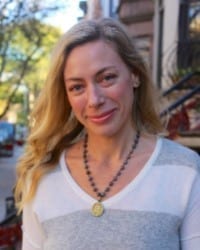
Have you ever faced a challenge from which you thought you’d already healed? If so, you’re in good company. Unending growth is part of the human condition. There will always be more to learn from, struggle with, and eventually release. We are always in some phase of recovery and forgiveness throughout our lives. Yet there are lessons to be gleaned in rising from the ashes. Facing obstacles makes us stronger and more resilient each time we find ourselves on the other side. When we can acknowledge the teaching within our pain or discomfort, we can more readily navigate the next challenge from that resolve. And each time we do, we know ourselves on a deeper, more profound level.
Yoga and meditation practices hone awareness and insight, and illuminate our samskaras. Interpreted from Sanskrit, samskaras are understood as the inherited patterns, or scars, we unconsciously repeat much to our detriment and delusion. This karmic loop continues from one lifetime to the next. By noticing our samskaras we may begin to break the cycle.
Noticing Scars Reveals Obstacles
As Patanjali describes in the Yoga Sutras, the kleshas, our collective obstacles, are the hinderances we must break through to reconnect with the true self. These obstacles keep us from understanding our real nature, as they are mental constructs put forth by societal conditioning—for most of us, immediately following birth. Understanding the five kleshas is key to integrating with who and what we actually are.
The kleshas are powerful tools for self-study. Each obstacle presents an opportunity to break through the veil of illusion that shrouds the eternal self in darkness. What lies beyond each obstacle is self-awareness, an opportunity to examine how the other obstacles may be operating in tandem with other aspects of the non-self.
Are the kleshas like a video game—meaning do you have to conquer the boss at the end of every level in order to advance to the next? Will there always be obstacles to navigate yet each time we level up we are faced with yet another test for an even deeper understanding of our truest nature? If it is in our dharma to continue grappling with some aspect of each obstacle, then we can also consider that any new neural pathways we create in this life may very well carry over into the next—which is good news for your next incarnate. If growth is indeed a process unending, understanding how these blocks may continue to show up can at the very least lay the framework for cultivating more acceptance and ease in our lives overall, despite adversity.
Here are the five obstacles that keep us from knowing who we truly are.
Avidya: Ignorance
Sutra 2.4: “Ignorance of our real nature is the source of the other four, whether they be dormant, weak, suspended or fully active.”
Sutra 2.5: “Ignorance is the failure to discriminate between the permanent and the impermanent, the pure and the impure, bliss and suffering, the Self and the non-Self.”
For many yoga and meditation practitioners, our first opportunity to break through this barrier may have already happened on the mat or cushion. Through the practice of being here now and establishing a direct line back to oneness, we’ve all felt something powerful and mysterious that pulsates deep within us, and developed a better understanding of creation and consciousness as we’ve all bared witnessed our own prana, qi, or life force—if only for a few fleeting moments in time. There’s an inner knowing that as our relationship to these practices deepen we will only experience more truth and more light, as the old, false parts of ourselves unravel and fall away.
Asmita: Egoism
Sutra 2.6: “Egoism, the limiting sense of “I,” results from the individual intellect’s attributing the power of consciousness to itself.”
We have been conditioned to believe that our status in the world bears more weight than the qualities about ourselves that make us who we are. As we continue to remove the many masks we wear and drop the facades about how we want the world around us to perceive us, we remember that underneath it all we are all the same: pure bliss consciousness. Egoism is creating an identity around the parts of ourselves that are fleeting. We forget that everything is impermanent. When we release ourselves from the mind’s false notions about itself, there can be a metaphorical death after death of layers of narcissism as we begin to transcend from vanity.
Raga: Attachments
Sutra 2.7: “Attachment is clinging to pleasure.”
In order to discover real contentment we have to learn how to practice non-attachment to the transient parts of our lives. We cling because we believe these impermanent things make us who we are, which can feed into egoism and shields the truth about who we really are beyond our attachments. It is difficult to loosen our grip because we are afraid that losing these aspects of ourselves will jeopardize the identities we’ve so carefully crafted. In order to deal with that discomfort, we may even turn to other distractions and coping mechanisms.
Dvesha: Aversions
Sutra 2.8: “Aversion is clinging to pain.”
Yoga is a coping mechanism, albeit a healthy one. The practice of presence illuminates our patterns and guides us toward living with more ease and acceptance as we learn how to be okay with what is in this ever-changing world. But yoga can become an unhealthy coping mechanism when it is used as quick fix or a temporary distraction from dealing with the inevitable. Some things are simply too difficult and painful to bear, so rather than dealing with pain—maybe through talk therapy or self-help tools—we continue to stuff it down. We cling to our traumas and hurts without even realizing it.
To practice non-clinging to pain would mean to fully accept it and learn how to coexist with it, not mask it or fix it or pretend it doesn’t exit. Drugs and alcohol are also coping mechanisms, obviously, and are used to numb pain and discomfort. This does is not in any way trying to equate yoga with drugs, but, it is worth examining whether yoga is “your drug of choice”… or whether it’s a dedicated practice of presence that makes you a better, more skillful participant with life.
Abhinidvesha: Fear
Sutra 2.9: “And the fear of death is a spontaneous feeling, deeply rooted in us all, no matter how learned we may be.”
We are afraid to die. We can either remain ignorant of the fact we are going to die or learn how to fully accept it. We can try placing false import on creating an identity that leaves behind an eternal legacy because we are afraid of never being relevant, or we can allow ourselves to be as we are and allow our path to unfold accordingly in alignment with our actual nature. We can cling to life and everything in it—or let it all go and see what comes back—and also be okay in knowing that not everything may return. We can choose to accept that this precious life is a gift, and that finding inner peace is more meaningful than anything that might transpire externally, or we can continue seeking temporary moments of relief from the discomfort of knowing that one day, we are going to die. For most of us, this is our greatest fear. But when we recognize that we are not in control, that being alive in a body for a brief moment in time is all that we truly have and is none short of a miracle, perhaps we can finally break through this fear and return back to our innermost source—our truest nature. The more connection we have with that source, the more peace, contentment, ease and acceptance we’ll integrate into our lives.
Source:
Sutra 2.4-9, “Treading the Path”; The Yoga Sutras of Patanjali translated and introduced by by Alistair Shearer. Sacred Teachings; Potter/Ten Speed/Harmony/Rodale, Mar 24, 2010.
—
 Andrea Rice is a writer, yoga and meditation teacher, and Wanderlust Festival presenter. Her articles and essays have appeared in The New York Times, Yoga Journal, The Wanderlust Journal, NY Yoga + Life, mindbodygreen, and SONIMA, among other publications. She has been teaching yoga since 2010, first in Brooklyn and Manhattan, and now in Raleigh, NC, where she currently resides. She is also co-authoring a book about the application of seasonal rhythms and yoga philosophy to modern life, which will be published by New Harbinger in early 2020. Connect with Andrea on Facebook, Instagram, and Twitter, and sign up for her quarterly newsletters on her website: www.andreariceyoga.com.
Andrea Rice is a writer, yoga and meditation teacher, and Wanderlust Festival presenter. Her articles and essays have appeared in The New York Times, Yoga Journal, The Wanderlust Journal, NY Yoga + Life, mindbodygreen, and SONIMA, among other publications. She has been teaching yoga since 2010, first in Brooklyn and Manhattan, and now in Raleigh, NC, where she currently resides. She is also co-authoring a book about the application of seasonal rhythms and yoga philosophy to modern life, which will be published by New Harbinger in early 2020. Connect with Andrea on Facebook, Instagram, and Twitter, and sign up for her quarterly newsletters on her website: www.andreariceyoga.com.